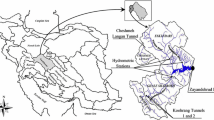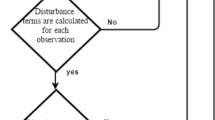Abstract
In this study, a new hybrid forecasting method is proposed. The proposed method is called autoregressive adaptive network fuzzy inference system (AR–ANFIS). AR–ANFIS can be shown in a network structure. The architecture of the network has two parts. The first part is an ANFIS structure and the second part is a linear AR model structure. In the literature, AR models and ANFIS are widely used in time series forecasting. Linear AR models are used according to model-based strategy. A nonlinear model is employed by using ANFIS. Moreover, ANFIS is a kind of data-based modeling system like artificial neural network. In this study, a linear and nonlinear forecasting model is proposed by creating a hybrid method of AR and ANFIS. The new method has advantages of data-based and model-based approaches. AR–ANFIS is trained by using particle swarm optimization, and fuzzification is done by using fuzzy C-Means method. AR–ANFIS method is examined on some real-life time series data, and it is compared with the other time series forecasting methods. As a consequence of applications, it is shown that the proposed method can produce accurate forecasts.














Similar content being viewed by others
References
Baş E, Eğrioğlu E et al (2015) Fuzzy-time-series network used to forecast linear and nonlinear time series. Appl Intell 43:343–355
Bezdek J, Ehrlich R et al (1984) FCM: the Fuzzy C-Means clustering algorithm. Comput Geosci 10(2–3):191–203
Catalao J, Pousinho H et al (2011) Hybrid wavelet–PSO–ANFIS approach for short-term wind power forecasting in Portugal. IEEE Trans Sustain Energy 2(1):50–59
Catalao J, Pousinho H et al (2011) Hybrid wavelet–PSO–ANFIS approach for short-term electricity prices forecasting. Power Syst 26(1):137–144
Catalao J, Osorio G et al (2011) Application of an intelligent system based on EPSO and ANFIS to price forecasting. In: IEEE ISAP
Chabaa S, Zeroual A et al (2009) ANFIS method for forecasting internet traffic time series. In: 2009 mediterrannean microwave symposium (MMS). IEEE, Tangiers, pp 1–4
Chang B (2008) Resolving the forecasting problems of overshoot and volatility clustering using ANFIS coupling nonlinear heteroscedasticity with quantum tuning. Fuzzy Set Syst 159(23):3183–3200
Chen S (1996) Forecasting enrollments based on fuzzy time series. Fuzzy Sets Syst 81(3):311–319
Chen S, Chang Y (2010) Multi-variable fuzzy forecasting based on fuzzy clustering and fuzzy rule interpolation techniques. Inform Sci 180(24):4772–4783
Chen S, Chen C (2011) TAIEX forecasting based on fuzzy time series and fuzzy variation groups. IEEE Trans Fuzzy Syst 19(1):1–12
Chen S, Chu H et al (2012) TAIEX forecasting using fuzzy time series and automatically generated weights of multiple factors. IEEE Trans Syst Man Cybern Part A Syst Hum 42(6):1485–1495
Chen B, Ma Z (2009) Short-term traffic flow prediction based on ANFIS. In: IEEE international conference on communication software and networks (ICCSN '09). IEEE, Macau, pp 791–793
Chen D, Zhang J (2005) Time series prediction based on ensemble ANFIS. In: 2005 IEEE international conference on machine learning and cybernetics, vol 6. IEEE, Guangzhou, pp 3552–3556
Cheng C, Wei L et al (2009) Fusion ANFIS models based on multi-stock volatility causality for TAIEX forecasting. Neurocomputing 72(16–18):3462–3468
Cheng C, Wei L et al (2013) Owa based ANFIS model for TAIEX forecasting. Econ Model 30:442–448
Cheng C, Hsu J et al (2009) Forecasting electronic industry EPS using an integrated ANFIS model. In: IEEE systems, man and cybernetics, pp 3467–3472
Chou P, Tsai J et al (2015) Adaptive Neuro-fuzzy inference system with evolutionary algorithm for designing process parameters of color filter. In: 2015 IEEE international conference on automation science and engineering (CASE)
Cordeschi N, Shojafar M et al (2015) Energy-efficient adaptive networked datacenters for the QoS support of real-time applications. J Supercomput 71:448–478
Eberhart R, Kennedy J (1995) A new optimizer using particle swarm theory. IEEE MHS 95:39–43
Escobar A, Perez L (2008) Application of support vector machines and ANFIS to the short-term load forecasting. In: IEEE transmission and distribution conference and exposition
Eğrioğlu E, Aladağ H et al (2014) A new adaptive network based fuzzy inference system for time series forecasting. Aloy J Soft Comput Appl 2:25–32
Gocic M, Motamedi S et al (2015) Soft computing approaches for forecasting reference evapotranspiration. Comput Elect Agric 113:164–173
Ho Y, Tsai C (2011) Comparing ANFIS and SEM in linear and nonlinear forecasting of new product development performance. Expert Syst Appl 38(6):6498–6507
Jang JS (1993) ANFIS: adaptive network based fuzzy inference systems. IEEE Trans Syst Man Cybern 23(3):665–685
Khadangi E, Madvar H et al (2009) Comparison of ANFIS and RBF models in daily stream flow forecasting. In: 2nd international conference on computer, control and communication, IC4 2009. IEEE, Karachi, pp 1–6
Li K, Su H et al (2011) Forecasting building energy consumption using neural networks and hybrid neuro-fuzzy system: a comparative study. Energy Build 43(10):2893–2899
Li H, Guo C, Yang S, Jin H et al (2006) Hybrid model of WT and ANFIS and its application on time series prediction of ship roll motion. In: IEEE IMACS multiconference on computational engineering in systems applications, vol 1. IEEE, Beijing, pp 333–337
Lohani A, Kumar R et al (2012) Hydrological time series modeling: a comparison between adaptive neuro-fuzzy, neural network and autoregressive techniques. J Hydrol 442–443:23–35
Mellit A, Arab H et al (2007) An ANFIS-based forecasting for solar radiation data from sunshine duration and ambient temperature. In: IEEE power engineering society general meeting
Mohammadi S, Keivani H et al (2006) Demand forecasting using time series modelling and ANFIS Estimator. In: IEEE Proceedings of the 41st international universities power engineering conference, vol 1. IEEE, Newcastle-upon-Tyne, pp 333–337
Moreno J (2009) Hydraulic plant generation forecasting in Colombian power market using ANFIS. Energy Econ 31(3):450–455
Patel P, Sharma V et al (2013) Guaranteed convergence particle swarm optimization using personal best. Int J Comput Appl 73(7):6–10
Peer E, van den Bergh F et al (2003) Using neighbourhoods with the guaranteed convergence PSO. IEEE SIS 03:235–242
Pousinho H, Catalao J (2010) Wind power short-term prediction by a hybrid PSO–ANFIS approach. IEEE MELECON 2010:955–960
Pousinho H, Mendes V et al (2012) Short-term electricity prices forecasting in a competitive market by a hybrid PSO–ANFIS approach. Int J Elect Power Energy Syst 39(1):29–35
Protic M, Shamshirband S et al (2015) Forecasting of consumers heat load in district heating systems using the support vector machine with a discrete wavelet transform algorithm. Energy 87:343–351
Shi Y, Eberhart R (2005) Empirical study of particle swarm optimization. In: Proceedings of the 1999 congress on evolutionary computation, CEC 99, vol 3. IEEE, Washington, pp 1945–1950
Shojafar M, Javanmardi S et al (2015) FUGE: a joint meta-heuristic approach to cloud job scheduling algorithm using fuzzy theory and a genetic method. Cluster Comput 18:829–844
Shoorehdeli M, Teshnehlab M et al (2009) Identification using ANFIS with intelligent hybrid stable learning algorithm approaches and stability analysis of training methods. Appl Soft Comput 9(2):833–850
Suhartono I, Faulina R et al (2012) Ensemble method based on ANFIS–ARIMA for rainfall prediction. In: 2012 international conference on statistics in science, business, and engineering (ICSSBE). IEEE, Langkawi, pp 1–4
Suhartono I, Puspitasari M et al (2012) Two-level Seasonal model based on hybrid ARIMA–ANFIS for forecasting short-term electricity load in Indonesia. In: 2012 international conference on statistics in science, business, and engineering (ICSSBE). IEEE, Langkawi, pp 1–5
Takagi T, Sugeno M (1985) Fuzzy identification of systems and its applications to modeling and control. Man Cybern 15(1):116–132
Tamura H, Tanno K et al (2008) Recurrent type ANFIS using local search technique for time series prediction. In: IEEE Asia pacific conference on circuits and systems, APCCAS 2008. IEEE, Macao, pp 380–383
Wei L (2016) A hybrid ANFIS model based on empirical mode decomposition for stock time series forecasting. Appl Soft Comput 42:368–376
Yun Z, Quan Z et al (2008) RBF neural network and ANFIS-based short-term load forecasting approach in real-time price environment. Power Syst 23(3):853–858
Yunos Z, Shamsuddin S et al (2008) Data modeling for kuala lumpur composite index with ANFIS. In: IEEE second Asia international conference on modeling and simulation, pp 609–614
Zhang G (2003) Time series forecasting using a hybrid ARIMA and neural network model. Neurocomputing 50:159–175
Author information
Authors and Affiliations
Corresponding author
Ethics declarations
Conflict of interest
The author declares that there is no conflict of interests regarding the publication of this paper.
Rights and permissions
About this article
Cite this article
Sarıca, B., Eğrioğlu, E. & Aşıkgil, B. A new hybrid method for time series forecasting: AR–ANFIS. Neural Comput & Applic 29, 749–760 (2018). https://doi.org/10.1007/s00521-016-2475-5
Received:
Accepted:
Published:
Issue Date:
DOI: https://doi.org/10.1007/s00521-016-2475-5




